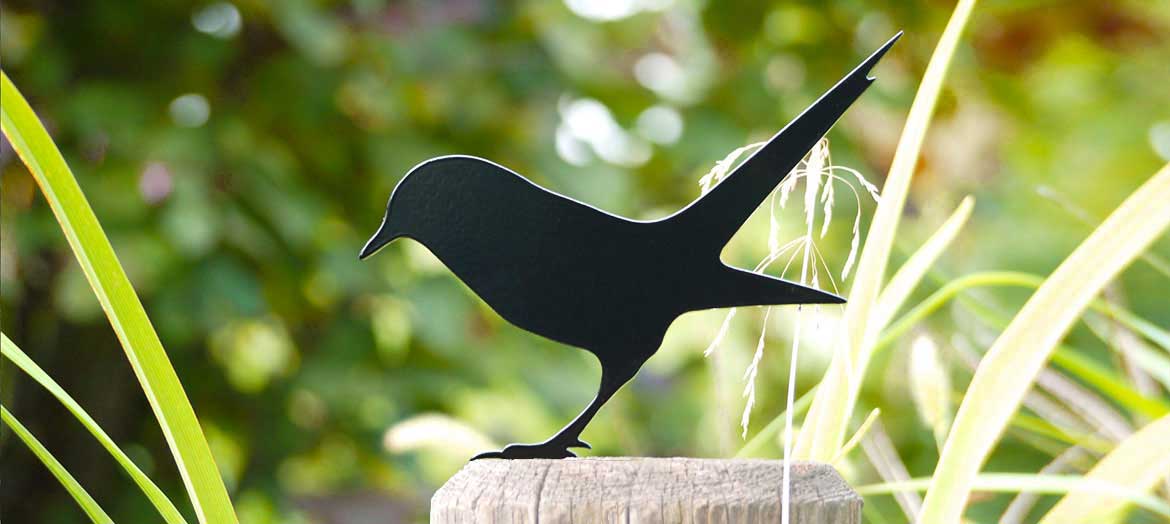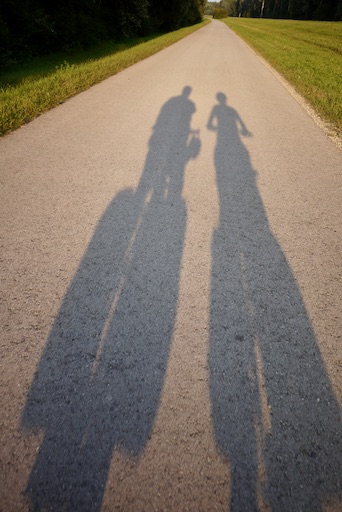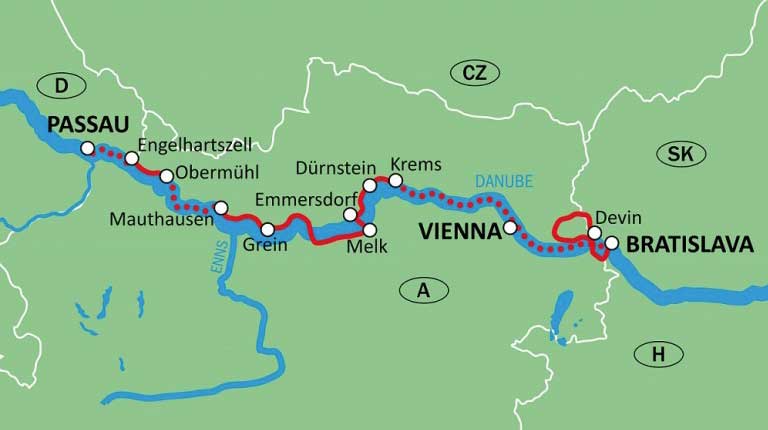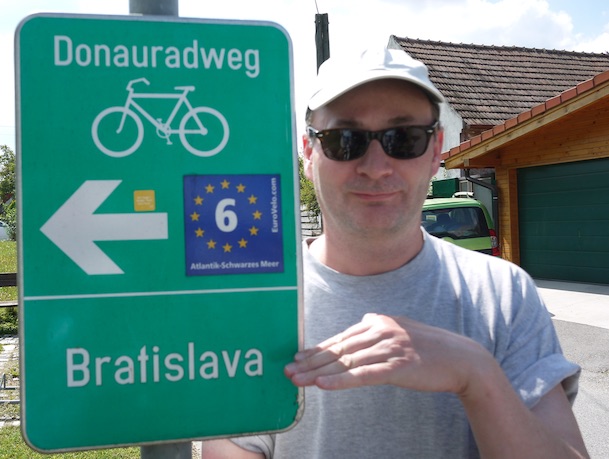
Cycling the Danube

Cycling from Passau to Bratislava along the Danube

Long Cycling Shadows
The ride begins at Passau on the German Austrian border and follows the beautiful Danube some 400 km downstream, all the way across Austria and into the beautiful Slovak capital, Bratislava.
Cycling along key European rivers is typically rewarding and easy going, this section of the Danube being probably the most pedalled and one of the most beautiful. The scenery is lovely, the paths are smooth, the signposts are good and there is no end of facilities for good sleeping and eating.
Around 38,000 cyclists per year travel this section of the Danube, making it by far Europe's most popular ride. Even so, you'll never see more than a few small groups of cyclists and they're typically a friendly bunch. If you cycle downstream as recommended, you'll see little in the way of opposing traffic.
Various companies offer to organise your tour for you, including bikes, accommodation and a lift back to Passau. We enjoy just a little adventure and so we like to take our chances. Even in the midst of Summer we had no problem booking accommodation on the day and at the location we needed it.
Not wanting to rush, but enjoying a steady pace, we imagined our tour would take a week - and we were about right.

Cycling the Danube
Passau to Bratislava along the Danube is around 400 km and crosses the whole of Austria
Preparation
We're not professional cyclists and rarely ride outside of the Summer holidays. Our bikes are old - with the advantage of not being very interesting to bike thieves. They are serviceable however and the Danube has lots of cyclists and thus lots of helpful bikers and bike shops to help you on your way should you have troubles. Getting something fixed won't be difficult, but could ruin your day if you have to push your bike to the next town. So - carefully check your bike over, ensuring everything is working as it should. Buy a spare inner tube and some thin kevlar-lined touring tyres, like Schwalbe Marathons. This will reduce rolling resistance and give you a good safe ride, whilst guarding against otherwise inevitable flatties. If you're not sure, get your bike serviced at your local cycle shop.
You'll need rear panniers and bags, don't go nuts though: just a couple of traditional Ortleib style hook-on bags will do the job (Aldi have very cheap ones which are more than sufficient for a week's cycling every year). If they're waterproof, all the better, but if you're anything like me, you'll be in the coffee shop watching the rain rather than driving through it. A detachable bag on the handle bars is a must for your wallet, keys, camera etc.
Obviously, you'll need a modest toolkit, pump, bell and some cheap strap-on lights just in case.
We tend to shy away from lycra, which has little benefit for the majority, except to relieve it of it's hard earned cash and accentuate said porper's bulges. There are a few common sense things you'll absolutely need though.
A cycle helmet is highly advisable. We've avoided them until now, but with more and more stories of cyclists suffering life changing brain injuries, our next cycle will be with hard hats !
Padded cycle shorts are a must. No bike seat was ever comfortable - so any relief you can get from bum pain will help. Applying Germoline liberally in the evening seems to refresh the parts other creams cannot reach, leaving you feeling ready to go again the next morning.
Definitely take a sun hat, sun cream, lightweight rain protection - but forget gloves, expensive shoes and so on. They're just not necessary. Take a simple first aid kit - and take a bike lock.
Dividing your belongings into 'departments' within your bags will help keep you organised. Plastic carrier bags will help separate the 'dirty washing department' from the 'clean underwear department' and so on.
Passau
The start of the ride is Passau. Passau in Lower Bavaria is a pretty town, the meeting of three rivers: the Donau (or Danube for the English), the Inn and the Ilz.
None of them are blue !
Passau is well connected, with trains to the major Cities. If you choose to drive there as we did, several City car parks offer great rates to leave your car securely whilst you cycle.
Accommodation is abundant, but you may choose to arrive later in the day and just make a start. We were itching to get started and so decided we'd cycle 20 Km or so, just to get into the groove a little. We found a terrific Gasthaus (guest house) shortly after crossing the Austrian border called Jausenstation Bernhard (Opposite Jochenstein on the south bank).
… more to come !

Summer 2016, Passau to Bratislava
<

Long Cycling Shadows
The ride begins at Passau on the German Austrian border and follows the beautiful Danube some 400 km downstream, all the way across Austria and into the beautiful Slovak capital, Bratislava.
Cycling along key European rivers is typically rewarding and easy going, this section of the Danube being probably the most pedalled and one of the most beautiful. The scenery is lovely, the paths are smooth, the signposts are good and there is no end of facilities for good sleeping and eating.
Around 38,000 cyclists per year travel this section of the Danube, making it by far Europe's most popular ride. Even so, you'll never see more than a few small groups of cyclists and they're typically a friendly bunch. If you cycle downstream as recommended, you'll see little in the way of opposing traffic.
Various companies offer to organise your tour for you, including bikes, accommodation and a lift back to Passau. We enjoy just a little adventure and so we like to take our chances. Even in the midst of Summer we had no problem booking accommodation on the day and at the location we needed it.
Not wanting to rush, but enjoying a steady pace, we imagined our tour would take a week - and we were about right.

Cycling the Danube
Passau to Bratislava along the Danube is around 400 km and crosses the whole of Austria
Preparation
We're not professional cyclists and rarely ride outside of the Summer holidays. Our bikes are old - with the advantage of not being very interesting to bike thieves. They are serviceable however and the Danube has lots of cyclists and thus lots of helpful bikers and bike shops to help you on your way should you have troubles. Getting something fixed won't be difficult, but could ruin your day if you have to push your bike to the next town. So - carefully check your bike over, ensuring everything is working as it should. Buy a spare inner tube and some thin kevlar-lined touring tyres, like Schwalbe Marathons. This will reduce rolling resistance and give you a good safe ride, whilst guarding against otherwise inevitable flatties. If you're not sure, get your bike serviced at your local cycle shop.
You'll need rear panniers and bags, don't go nuts though: just a couple of traditional Ortleib style hook-on bags will do the job (Aldi have very cheap ones which are more than sufficient for a week's cycling every year). If they're waterproof, all the better, but if you're anything like me, you'll be in the coffee shop watching the rain rather than driving through it. A detachable bag on the handle bars is a must for your wallet, keys, camera etc.
Obviously, you'll need a modest toolkit, pump, bell and some cheap strap-on lights just in case.
We tend to shy away from lycra, which has little benefit for the majority, except to relieve it of it's hard earned cash and accentuate said porper's bulges. There are a few common sense things you'll absolutely need though.
A cycle helmet is highly advisable. We've avoided them until now, but with more and more stories of cyclists suffering life changing brain injuries, our next cycle will be with hard hats !
Padded cycle shorts are a must. No bike seat was ever comfortable - so any relief you can get from bum pain will help. Applying Germoline liberally in the evening seems to refresh the parts other creams cannot reach, leaving you feeling ready to go again the next morning.
Definitely take a sun hat, sun cream, lightweight rain protection - but forget gloves, expensive shoes and so on. They're just not necessary. Take a simple first aid kit - and take a bike lock.
Dividing your belongings into 'departments' within your bags will help keep you organised. Plastic carrier bags will help separate the 'dirty washing department' from the 'clean underwear department' and so on.
Passau
The start of the ride is Passau. Passau in Lower Bavaria is a pretty town, the meeting of three rivers: the Donau (or Danube for the English), the Inn and the Ilz.
None of them are blue !
Passau is well connected, with trains to the major Cities. If you choose to drive there as we did, several City car parks offer great rates to leave your car securely whilst you cycle.
Accommodation is abundant, but you may choose to arrive later in the day and just make a start. We were itching to get started and so decided we'd cycle 20 Km or so, just to get into the groove a little. We found a terrific Gasthaus (guest house) shortly after crossing the Austrian border called Jausenstation Bernhard (Opposite Jochenstein on the south bank).
… more to come !

Summer 2016, Passau to Bratislava
<
